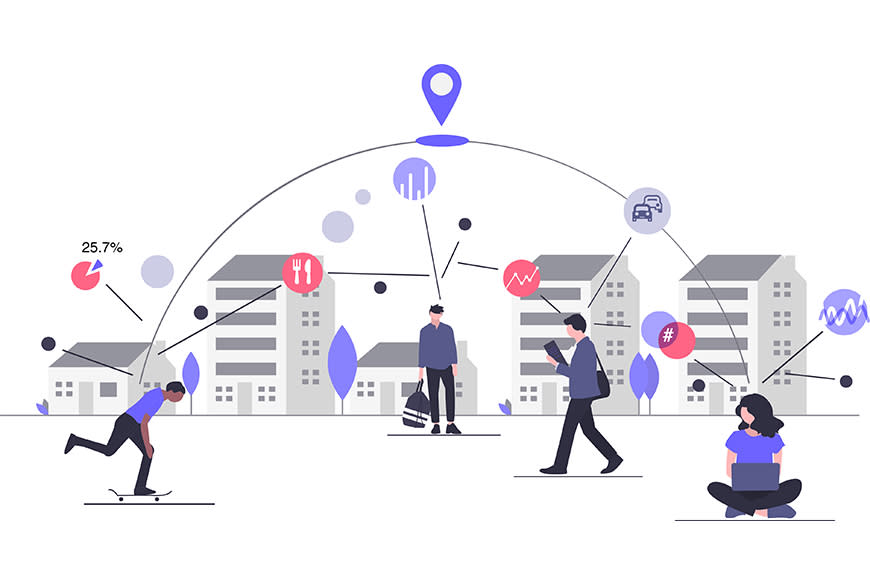
What are we talking about when we talk about smart cities? Ray Wang, in his book Disrupting Digital Business, introduces the idea of “mass personalization at scale.” This, it seems, is the heart of the matter: mass personalized urbanism at scale. Could this be the true democratization of urbanism? I believe so.
Personalized urbanism is a dream that will be enabled by the movement toward, aggregation of, and acceleration of data, artificial intelligence, and machine learning. When we imagine the future of smart cities, we often wonder what technology can do to optimize our infrastructures—how our governments and utility companies manage and reduce energy consumption, track and monitor the flow of transportation, and collect real-time location data. While all of these things are becoming more standardized as cities, governments, institutions, and businesses undergo digital transformation, a quieter revolution is underway, altering the way we experience our cities at the personal level.
Do you remember some years ago when we could turn on our location sharing on Google Maps for our friends or family to see? When this experiment launched, I turned it on… and then quickly realized that I didn’t want to be tracked or share my location data. Today, however, many people share all kinds of data, without the slightest hesitation, in exchange for convenience.
As we normalize behaviors around sharing location data with anonymous peers in services like Didi or Uber, the content we consume with search engines like Google or Baidu, our browsing and shopping preferences with e-commerce platforms like Amazon or Taobao, and our social conversations and threads on Facebook and WeChat, we not only give up our data for companies to make money off of us, but we also contribute to larger data sets that not only analyze but shape trends to drive real or imagined demand.
Today we are walking, breathing, and expressing datasets, whether or not we’re even aware of it (Wang talks about “digital exhaust”). The increased granularity of our behaviors captured as data augments our interactions in the world, online, offline, and socially. How we choose to interact becomes a question of who has access to our data and preference settings. Should each of us have data models of our behaviors and easy preference controls regarding how we want to engage? More and more, this kind of information is becoming as valuable as information about our genetic makeup.
How many of you have ever reached out to a friend because you saw a social media post locating them right around the corner from you? You couldn’t imagine this scenario ten years ago. This type of serendipity is gold, and one of the joys of city living. These interactions are enabled by the settings we place on our data, and how that data can be shared with us by all the companies that currently own it. The way things are now, our data and behavior patterns go into a black box collected by the various touchpoints owned and operated by different companies, to be sorted, organized, and used in different ways to learn about and push products and services to us. What if more of our data were shared with us, allowing us—not just companies, institutions, and services—control over how we engage with the people close to us? At the end of the day, data is neutral. How we want to augment our experience with data can impact the way we live, work, and play, our interactions with each other, with our community, and with the place we live.
Let’s imagine a near-future scenario where we can use our data more deliberately… as you walk your dog in your neighborhood, you’re alerted that your friend Amy is having breakfast at a café you are walking past. It’s been ages since you’ve seen each other, so you stop in to have coffee together before you go about your day to run errands. She’s stressed out because she’s looking for an apartment to rent and her lease is up in two weeks. You check your building, and see that Sam is out of town on those dates and would be interested in renting out his apartment. Later in the afternoon, a group of friends start having a chat about making dinner together. You each share the contents of your refrigerator and are offered recipes using the collective ingredients in your homes. Oops, no one has eggs for that carbonara recipe? No worries, you can see that your next-door neighbor has a few to spare, so you purchase some directly from him. Your collective location data suggests that Yuri is the most centrally located, but Sarah has the most space to host and is only a few blocks east. On the way to Sarah’s for dinner, a menu pops up from Yuri’s favorite dessert shop with suggestions of his favorite pie. You decide to pick one up as it’s a nice addition to the dinner.
Does this sound creepy, or joyful? It depends on the strength of our relationships to those with whom we interact. At the end of the day, technology is an enabler for how we want to experience the world. In many ways, this scenario is no more or less intimate than the relationships people had in the close proximity and lack of privacy experienced in villages. Personalizing our city with smart technologies allows us to engage with people, things, and places in granular ways.
The promise of the internet is greater connectivity regardless of physical location. As the virtual world mirrors social communal norms, we’re witnessing the effects of advanced social networks. The concept of the global village has been realized and is showing the gap between human interaction in the physical and virtual realms. While the “smart” in smart cities is about the technology, personalization is about our attachments to people, places, and experiences. A more human, personalized city is a way forward in creating greater connectivity, intimacy, and ultimately a more joyful urban life.
Illustration by Ben Yi




